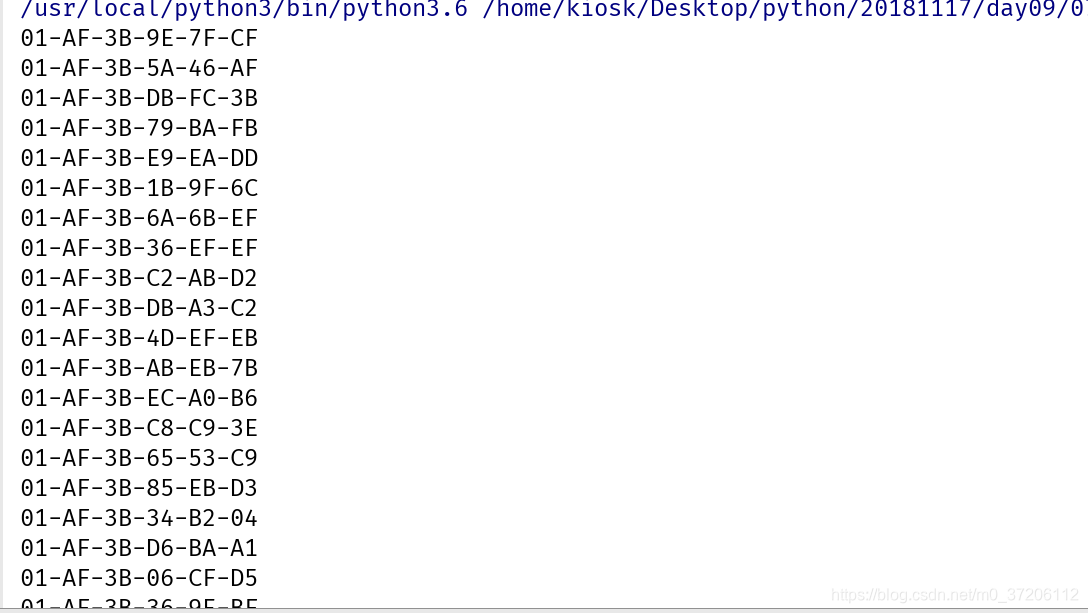python基礎--檔案操作,os模組
檔案操作
檔案讀取的三部曲:開啟—>操作---->關閉
r:(預設)
-只能讀,不能寫
-讀取檔案不存在,會報錯
FileNotFoundError: [Errno 2] No such file or directory:
w:
-write only
-檔案不存在,不報錯,並建立新的檔案
-檔案存在,會清空檔案內容並寫入新的內容
a:
-write only
-寫:檔案不存在,不報錯,並建立新的檔案
-寫:不會清空原檔案的內容,會在檔案末尾追加
a+:
-rw
-檔案不存在,不報錯
-不會清空檔案內容,在末尾追加
r+:
-讀寫
-檔案不存在,報錯
-預設情況下,從檔案指標所在的位置開始寫入
w+:
-rw
-檔案不存在,不報錯
-會清空檔案內容
“”"
開啟檔案 f = open('/tmp/passwd') print(f) 操作 告訴當前檔案指標所在的位置 print(f.tell()) content = f.read() print(content) print(f.tell()) 讀操作 print(f.read()) 寫操作 f.write('python') 判斷檔案物件擁有的許可權 print(f.readable()) print(f.writable()) f.write('python') 關閉 print(f.read()) print(f.tell()) f.close() f = open('/tmp/passwd','r+') print(f.read()) f.write('123') print(f.read()) f.close()
非純文字檔案的讀取
如果讀取圖片,音訊或視訊(非純文字檔案),需要通過二進位制的方式進行讀取與寫入
-讀取文字檔案
r r+ w w+ a a+ == rt rt+ wt wt+ at at+
-讀取二進位制檔案
rb rb+ wb wb+ ab ab+
先讀取二進位制檔案內容
f1 = open('1111.jpg', mode='rb')
content = f1.read()
print(content)
f1.close()
f2 = open('hello.jpg', mode='wb')
寫入要複製的檔案讀到的內容
f2.write(content) f2.close()
檔案的常用操作
f = open(’/tmp/passwd’, ‘r’)
預設情況下讀取檔案的所有內容,小的檔案,直接用read讀取即可
如果是一個大檔案(檔案大小>記憶體大小) readline()
#類似於head -c
print(f.read(3))
#4g 5g
每次讀取一行內容
print(f.readline())
print(f.readline())
讀取檔案內容,返回一個列表,列表元素分貝為檔案的行內容
print(f.readlines())
print(f.readable())
對於每一行,去掉後面的'\n' ---(列表生成式 map())
print([line.strip() for line in f.readlines()])
print(list(map(lambda x:x.strip(),f.readlines())))
f.close()
f = open('/tmp/passwd','rb')
f.write('hello') #從指標所在位置寫入,寫的就是字串的內容
f.writelines(['a','b']) #將列表中的每個元素寫入檔案
f.writable()
指標的操作
print(f.tell())
print('1:',f.read(3))
print(f.tell())
f.seek(0,2)
"""
seek:移動指標
第一個引數:偏移量>0:代表向後移動 <0:代表前移動
第二個引數:
0:移動指標到檔案開頭
1:當前位置
2:移動指標到檔案末尾
"""
print(f.tell())
f.close()
檔案練習
建立檔案data.txt,檔案共100000行,每行存放一個1~100之間的整數
import random
f=open('data.txt','a+')
for i in range(100000):
f.write(str(random.randint(1,101))+'\n')
f.seek(0,0)
#print(f.read())
print([i.strip() for i in f.readlines()])
#print(list(map(lambda x:x.strip(),f.readlines())))
f.close()

with
上下文管理器:開啟檔案,執行完with語句內容之後,自動關閉檔案物件
f = open('/tmp/passwd')
with open('/tmp/passwd') as f:
print('with語句裡面:',f.closed)
print(f.read())
print('after with語句:',f.closed)
#python2(只能這麼寫)
with open('/tmp/passwd') as f1:
content = f1.read()
with open('/tmp/passwdbackup','w+') as f2:
f2.write(content)
#python3
with open('/tmp/passwd') as f1,\
open('/tmp/passwdbackup','w+')as f2:
# 將第一個檔案的內容寫入第二個檔案中
f2.write(f1.read())
# f2.seek(0,0)
# f2.read()
通過yield實現檔案的讀取
def bylineread(fimename):
with open(fimename) as f:
line = f.readline()
while line:
yield line
line = f.readline()
read是一個生成器物件
read = bylineread('data.txt')
print(read)
1.next讀取生成器內容
print(next(read))
print(next(read))
for
for item in read:
print(item)
檔案物件是可以for迴圈遍歷的
from collections import Iterable
f = open('data.txt')
print(isinstance(f,Iterable))
for i,item in enumerate(f):
if i == 10:
break
print(i,item)
檔案練習–生成MAC地址
生成100個MAC地址並寫入檔案中,MAC地址前6位(16進位制)為01-AF-3B
01-AF-3B-xx-xx-xx
-xx
01-AF-3B-xx
-xx
01-AF-3B-xx-xx
-xx
01-AF-3B-xx-xx-xx
import string
import random
#隨機生成一個MAC地址的函式
def creat_mac():
MAC= '01-AF-3B'
# 生成16進位制的數
hex_num = string.hexdigits
for i in range(3):
# 從16進位制字串中隨機選出2個數來(返回值為列表)
n = random.sample(hex_num,2)
# 拼接列表中的內容,將小寫字母轉換為大寫
sn = '-' + ''.join(n).upper()
MAC += sn
return MAC
#主函式,隨機生成100個MAC地址
def main():
# 以寫的方式開啟檔案
with open('mac.txt','w') as f:
for i in range(100):
mac= creat_mac()
print(mac)
# 每生成一個MAC地址,存入檔案(注意換行)
f.write(mac+'\n')
main()

檔案練習–生成ip和排列ip
京東二面程式設計題
1.生成一個大檔案ips.txt,要求1200行, 每行隨機為172.25.254.0/24段的ip;
2.讀取ips.txt檔案統計這個檔案中ip出現頻率排前10的ip;
import random
def create_ip_file(filename):
ips = ['172.25.254.' + str(i) for i in range(0,255)]
print(ips)
with open(filename,'a+') as f:
for count in range(1200):
f.write(random.sample(ips,1)[0] + '\n')
#create_ip_file('ips.txt')
def sorted_ip(filename,count=10):
ips_dict = dict()
with open(filename) as f:
for ip in f:
if ip in ips_dict:
ips_dict[ip] += 1
else:
ips_dict[ip] = 1
sorte_ip = sorted(ips_dict.items(),key=lambda
x:x[1],reverse=True)[:count]
return sorte_ip
print(sorted_ip('ips.txt'))

讀取檔案方式效率對比
import functools
import time
def timeit(fun):
"""這是一個裝飾器timeit"""
@functools.wraps(fun) #可以保留被裝飾函式的函式名和幫助資訊文件
def wrapper(*args, **kwargs): # 接收可變引數和關鍵字引數
"""這是一個wrapper函式"""
# args:元組 kwargs:字典
# 在函式執行之前
start_time = time.time()
# 執行函式
res = fun(*args, **kwargs)
# 函式執行之後
end_time = time.time()
print('執行時間為:%.6f' % (end_time - start_time))
return res
return wrapper
@timeit
def read1(filename):
# for 迭代
with open(filename) as f:
for line in f:
# 對檔案的處理操作
line = int(line.strip())
line = line + 1
@timeit
def read2(filename):
with open(filename) as f:
for line in f.readlines():
line = int(line.strip())
line = line+1
#
#
#
#
#
read1('data.txt')
read2('data.txt')
@timeit
def copy(sourcefile,destfile):
with open(sourcefile) as f1:
content = f1.read()
with open(destfile,'w') as f2:
f2.write(content)
@timeit
def copy1(sourcefile,destfile):
with open(sourcefile) as f1,open(destfile,'w')as f2:
# for line in f1:
# f2.write(line)
f2.write(f1.read())
copy('data.txt','data_1.txt')
copy1('data.txt','data_2.txt')
通過計時器對進行裝飾,發現python內建的方法的執行時間明顯短。
os模組
對於字典裡面巢狀字典進行排序
d = {
'003':{
'name':'apple1',
'count':100,
'price':10
},
'002':{
'name':'apple2',
'count':200,
'price':2
}
}
print(d.items()) #[('key',{}),(),()]
x:('003', {'name': 'apple1', 'count': 100, 'price': 10})
print(sorted(d.items(),key=lambda x:x[1]['count']))
print(sorted(d.items(),key=lambda x:x[1]['price']))
import os
1.返回作業系統型別 值為:posix,是Linux作業系統 值為nt,是windows作業系統
print(os.name)
print('Linux' if os.name == 'posix' else 'Windows')
2.作業系統的詳細資訊
info = os.uname()
print(info)
print(info.sysname)
print(info.nodename)
3.系統的環境變數
print(os.environ)
4.通過key值獲取環境變數對應的value值
print(os.environ.get('PATH'))
5.判度是否為絕對路徑 /tmp/passwd data.txt
print(os.path.isabs('/tmp/passwd3'))
print(os.path.isabs('hello'))
6.生成絕對路徑
print(os.path.abspath('hello.png'))
print(os.path.join('/home/kiosk','hello.png'))
print(os.path.join(os.path.abspath('.'),'hello.png'))
7.獲取目錄名或檔名
filename = '/home/kiosk/PycharmProjects/20181117/day09/hello.png'
print(os.path.basename(filename))
print(os.path.dirname(filename))
8.建立目錄 刪除目錄
mkdir mkdir -p
os.makedirs('img/file1/file2')
os.mkdir('img')
os.rmdir('img')
9.建立檔案 刪除檔案
os.mknod('00_ok.txt')
os.remove('00_ok.txt')
10.檔案重新命名(mv)
os.rename('data.txt','data1.txt')
11.判斷檔案或目錄是否存在
print(os.path.exists('ips.txt'))
12.分離字尾名和檔名
print(os.path.splitext('hello.png'))
13.將目錄和檔名分離
print(os.path.split('/tmp/hello/hello.png'))
os練習–建立學生目錄
完成自動建立100個目錄,目錄名稱為學生學號,
學號的前四位均為‘0405’,
學號總計為8位。舉例如學號04050001
import os
sid = 4050001
for i in range(1,101):
res_sid = '0' + str(sid + i)
os.mkdir(res_sid)
sid_pre = '0405'
for i in range(1,101):
i = str(i)
i_len = len(i)
if i_len == 1:
sid_last = '000' + i
elif i_len ==2:
sid_last = '00' + i
elif i_len == 3:
sid_last = '0' + i
else:
pass
res_sid = sid_pre + sid_last
os.mkdir(res_sid)

os練習
1.在當前目錄新建目錄img, 裡面包含多個檔案, 檔名各不相同(X4G5.png)
2.將當前img目錄所有以.png結尾的字尾名改為.jpg
import os
import string
import random
def gen_code(len=4):
# 隨機生成4位的驗證碼
li = random.sample(string.ascii_letters + string.digits, len)
return ''.join(li)
def create_file():
# 隨機生成100個驗證碼
li = {gen_code() for i in range(100)}
os.mkdir('img')
for name in li:
os.mknod('img/' + name + '.png')
#create_file()
def modify_suffix(dirname, old_suffix, new_suffix):
"""
:param dirname:操作的目錄
:param old_suffix: 之前的字尾名
:param new_suffix: 新的字尾名
:return:
"""
# 1.判斷查詢的目錄是否存在,如果不存在,報錯
if os.path.exists(dirname):
# 2.找出所有以old_suffix(.png)結尾的檔案
pngfile = [filename for filename in os.listdir(dirname)
if filename.endswith(old_suffix)]
# pngfiles = filter(lambda filename:filename.endswith(old_suffix)
# ,os.listdir(dirname))
# 3.將檔名和字尾名分開,留下檔名
basefiles = [os.path.splitext(filename)[0] for filename in pngfile]
print(basefiles)
# 4.檔案重新命名
for filename in basefiles:
#需要加上目錄名
oldname = os.path.join(dirname,filename+old_suffix)
newname = os.path.join(dirname,filename+new_suffix)
os.rename(oldname,newname)
print('%s命名為%s成功' %(oldname,newname))
else:
print('%s不存在,不能操作....' %(dirname))
modify_suffix('img','.jpg','.png')

